July 10, 2006 – Sepilok Rehabilitation Center (Orangutans), Sandakan
We ate with Judy and Rick – the standard massive breakfast buffet. I’m starting to tire of omelets.
We left the hotel at 8 for the Sepilok Orangutan Rehabilitation Center. YaYa is our new local guide. He’s a very sexy sea gypsy from a tribe in Borneo that lives on the water and throws their new babies into the river to sink or swim. (They don’t do it any more I’m told.) YaYa is a charmer with a radio announcer’s voices and bedroom eyes.
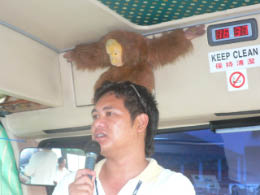
YaYa on the bus |
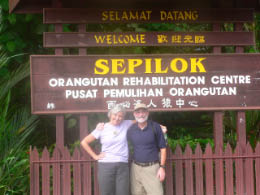
Bill and Nancy at Sepilok
|
YaYa told us all about the Orangutans at the center. Beware of Mr. G-Man, that naughty Alpha male. Don’t wear bright colors or jewelry.
A British society lady, Barbara Harrisson, started the Sepilok Rehabilitation Center. She was the wife of Tom Harrisson, a legendary war hero in Borneo and
curator of the Sarawak Museum.
He parachuted into the interior of Japanese-held Borneo during WWII and led the hill tribes in war; and then hung out with them during times of peace. You can read all about his exploits in his book, World Within – A Borneo Story published in 1959.
Enough of Hubby Tom, back to Barbara’s story. She was given a baby Orangutan for her birthday and wanted to return it to the wild. One thing lead to another, and before long, she inadvertently started the Sepilok Rehabilitation Center.
The word, “orangutan” means man (orang) of the forest (utan).
They catch most of the diseases that affect us and share 96.4 of our human genes.
They are wonderful, intelligent creatures who are fairly solitary animals. They have learned to resolve conflicts without fighting
(guess they didn’t get our war genes). The male pretty much just says “Hello” to the female while they mate and that’s about it. However, the babies spend 7 or 8 years
exclusively
with their moms. The moms have a lot to teach them. The mothers only have 4 or 5 babies in their lifetime (which contributes to the endangered species status).
They are on the critically endangered list and face extinction in 10 years if nothing is done and what ashame that would be.
Orangutans build a nest of twigs and leaves in the trees each time they settle in for a rest. Their strong hands and feet grip the branches firmly even when they are in deep slumber. After a one-time use, they leave the nest behind because their smell is strong and distinctive and easily attracts their predators. (An orangutan builds about 30,000 nests in a lifetime.)
The center is very nice. We first watched a 30-minute intro video. New arrivals spend 90 days in the quarantine room so they won’t spread anything to the other resident Orangutans. The nursery is like a kindergarten program where the young are taught climbing and other Orangutan skills. If they refuse to learn the skill, they get no dinner. Then, the next day, the trainer puts the dinner (e.g. a couple of bananas) on top of the tree to encourage climbing or places the dinner on whatever skills they are failing at to encourage them to get with the program.
After kindergarten, the Orangutans move on to a larger area and have their choice of where to live and a choice of who their friends are.
After the video, we walked along raised planks through the tropical jungle to one of the designated feeding stations. The feeders give boring food out to the Orangutans, a little milk with string beans and bananas. The goal is to eventually have the Orangutans
become so bored with the food that they WILL
NOT come back. Instead they will return completely to the wild for far more interesting meals.
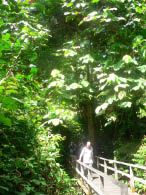
Path to the Viewing Platform |
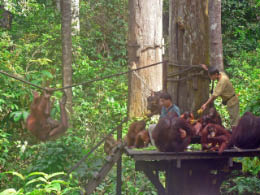
Orangutans and keepers
|
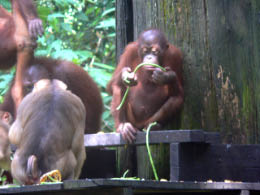
Boy, this is delicious! |
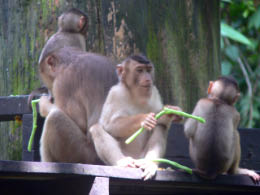
Macaque sharing lunch |
That morning we saw 12 Orangutans plus a lot of naughty Macaque monkeys who showed up for the free breakfast.
We saw G-Man. right away, the dominant male that can be a real pistol, according to YaYa.
To our amazement, Orangutans made their entrance to the feeding platform by swinging on ropes tied between the trees. They came from two different directions and displayed remarkable gymnastic skills. Swinging from trees looked so easy.
Two workers handed out the food and watched out for each other. An Orangutan has four times the strength of a man – so the humans are NOT interested in trying for the dominant male role. We saw one Orangutan shove a keeper from the back. I felt the fear all the way to the viewing stand. The crisis was abated when our human tucked his head and went into a most subordinate role.
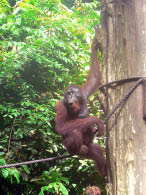
G Man |
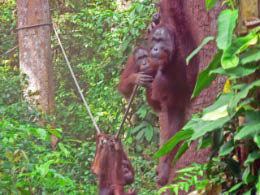
Orangutans
|
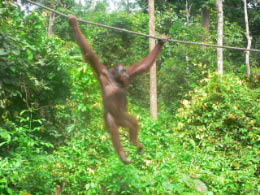
Orangutans
|
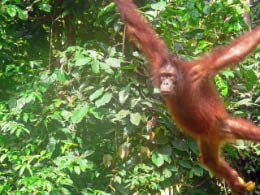
Orangutans |
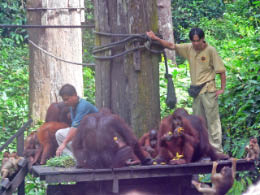
Feeding Time |
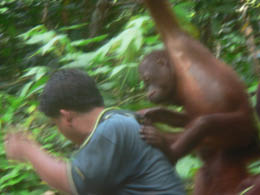
That shirt looks good |
For well over an hour, we stood in their territory (not a protected zoo), in the oppressive heat and watched the Orangutans going about their business -- eating their bananas and beans; getting a little scrappy with each other and/or with the Macaques; or just hanging out on the ropes, without a care in the world.
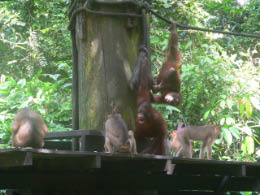
Why can't we all just get along? |
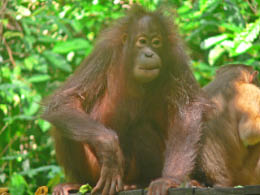
Not a care in the world
|
One Orangutan got a little frisky and stepped onto the viewing platform and tried to join our group of Oranguputas (man – white). YaYa warned the group in a serious and firm voice, “Move back slowly. No eye contact.” Pretty exciting. The Orangutans have been known to disrobe members in the audience and take away cameras, purses, whatever they want.
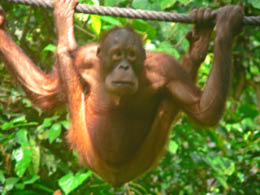
Can you do this? |
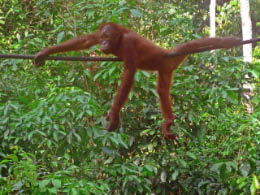
On the ropes
|
The breakfast group of Orangutans stayed around until almost 11 o’clock – a long time for them to hang out, according to YaYa. I bought Zi a stuffed Orangutan in the small gift shop where crowds were dying to spend their ringgets.
Everyone was excited about our encounter with the Orangutans that morning. On the way back from the Orangutan Rehab Center, we stopped at an Australian POW war memorial in Taman Rimba, close to the city of Sandakan where 2,400 Australians and British soldiers were held by the Japanese. Only 6 Australian soldiers survived the camp (and no British). A similar camp in the Philippines is the subject of a very good 2005 movie, The Great Raid.
The prisoners were forced to build an airstrip for the Japanese Military. Later, the Japanese sent them on three horrible death marches.
I read in horror all the stories of life at the camp, cruel treatment by the Japanese soldiers, ulcers, malaria, disease, hard work with little food, or clothing or even boots to wear. Awful, awful. All over Malaysia, our guides told us of the atrocities the Japanese committed against them during the war – almost unspeakable. They are angry at Thailand for giving the Japanese access to their country – like being stabbed in the back by a friend. The wounds have not healed.
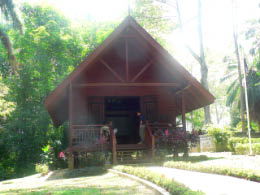
War Memorial |
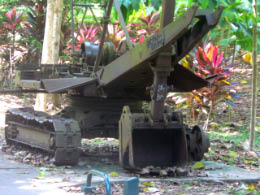
Left over from WWII
|
In spite of it’s terrible history, the place has been transformed into a beautifully landscaped park with lily ponds, rolling hills, and rusting bits of machinery left behind as a monument to what happened here. The place has an eerie feeling about it.
History of the War Memorial:
After the fall of Singapore and Borneo to the Japanese, a POW Camp was established just outside of Sandakan to house approximately 750 British and more than 1650 Australian prisoners from 1942 to 43.
In 1945, when the Japanese realized that the war may have been lost, and the Allies were closing in, the emaciated prisoners were forced to march, in three separate marches, to the village of Ranau in the jungle, 150 miles away, under the shadows of Mount Kinabalu.
On 28 January, 1945, 470 prisoners set off, with only 313 arriving in Ranau. On the second march, 570 started from Sandakan, but only 118 reached Ranau.
The third march had 537 prisoners, last of the prisoners from the Sandakan camp. Prisoners who were unable to walk were shot. The march route was through virgin jungle infested with crocodiles, snakes and wild pigs, and some of the prisoners had no boots. Rations were less than minimal. The march took nearly a year to complete.
Once the surviving prisoners arrived in Ranau, they were put to work carrying heavy sacks of rice over very hilly terrain to Paginatan, 25 miles away. By the end of July, 1945, there were no prisoners left in Ranau.
Only six Australians of the 2400 prisoners survived, by escaping into the jungle during the march from Sandakan or from the camp at Ranau. No British prisoners survived. Those who escaped were cared for by local natives.
This part of the war is considered by many to be the worst atrocity ever suffered by Australian soldiers, and compares to the atrocities of the Burma Railway, where fewer Australian POW's lost their lives. |
We went back to our hotel for lunch. I loved the Tom Yum soup and rolls and ignored the rest of the buffet items. Tobi joined us.
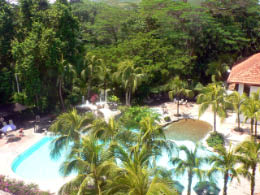
Sabah Hotel Pool |
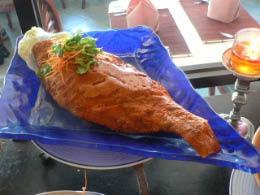
Is this edible?
|
After lunch, we went back to the room and watched “Wag the Dog,” with Dustin Hoffman. I forgot that it was so funny.
We met YaYa at the bus for the 2:00 pm tour of Sandakan.
YaYa Notes on the Bus
Sandakan, Sabah's second largest town on the east coast, was founded in 1879 by Englishman William B Pryer. Scot William Clarke Cowe set up the first European settlement on the northeastern coast of Sabah. The land was a gift from the Sultan for providing weapons.
Palm oil is very big business in Sandakan.
YaYa told us how the government is building up the tourism industry. They are very strict in testing and certifying tour guides and companies. Tour buses must be retired after seven years. Special licenses for the drivers are required.
The government is very serious about sane drivers. New drivers must display the letter “P” (for Probation) in their back window for 2-years. They can lose their driving status if they get a certain number of tickets. Also, when a person reaches 70, the license is taken away – no questions asked.
YaYa told us about a problem with “squatters.” Because housing is so expensive, people build their homes on a river -- no need to buy property, I suppose. They build up their houses little by little (a pillar one month, then the structure, then the floor, next a wall, etc.). This causes real problems with pollution and sewage, as you might imagine. Thomas said that the children in these areas will go to school and will be educated about the importance of a clean environment. To see some of the rivers covered in garbage and to hear a positive voice of hope for the future was very strange to me, the cynic.
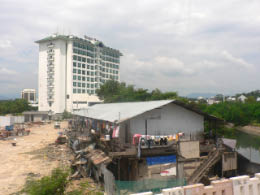
Squatter housing |
|
We stopped at a famous author’s house – Agnes Newton Keith, the daughter of a Del Monte Company executive who attended the University of California at Berkeley in the 1920’s. She met her British husband Harry through her brother. They were married in 1929 and immediately headed for Borneo where he was Conservator of Forest and Curator of the North Borneo Museum during the British heyday. She was bored with the twenty some odd British Society ladies and their teas and chatter so husband Harry encouraged her to write.
Her first book, Land Below The Wind, was about life in North Borneo in the 1930s. Her second book, Three Came Home,
was about her confinement in a WW II Japanese prison camp. It was made into a movie in 1950
starring Claudette Colbert. She said she was sorry she didn't look like Claudette Colbert. . White Man Returns was her third book. She wrote seven internationally acclaimed books.
She loved their two-story colonial wooden villa on the beautiful hill covered with lush tropical jungle.
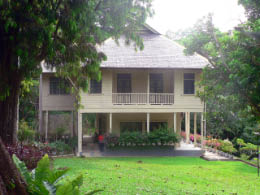
Agnes Keith's House |
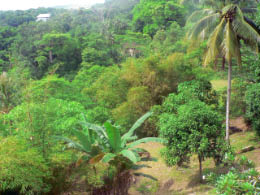
View from the house
|
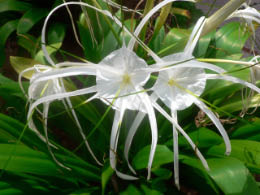
Flowers on the grounds |
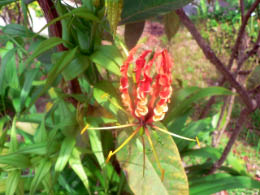
Flowers on the grounds |
Agnes and their young son, George, were POW’s for three years during the Japanese occupation. She stuck her journal pages in his baby shoes to hide them from the Japanese. Later she wrote the book,
Three Came Home, about her POW experiences.
After the war, they returned to Borneo and rebuilt the house on the hill. Then, after 30 years, they moved to the Philippines. The house was decorated with the things she would have had. I loved the picture of the natives helping themselves to ice cream from her new refrigerator and the photo of her holding a little baby Orangutan. What a cool, amazing lady. She and her husband retired to Victoria, Canada and lived out their final years in the Empress Hotel. Their son, George, carried on with his father’s work in Borneo.
The next stop was a very wealthy Chinese temple with three large Buddha’s displayed – one with nothing in his hand represents the present, one represents meditation and one represents medical healing. The temple is a mixture of Tao and Buddhism – lots of bright red colors and dragons.
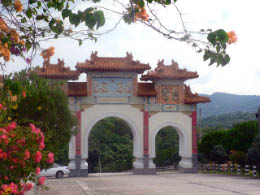
Chinese Temple, Sandakan |
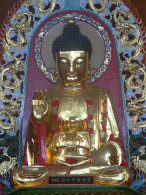
Temple Buddha
|
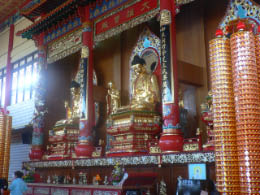
Inside the temple |
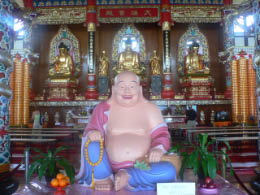
Happy Buddha |
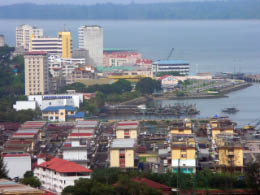
View of Sandakan from the Temple |
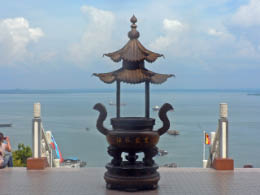
Looking out from the temple |
Our last bus stop was to have tea at the Sea Gypsies water village (called Sim Sim). It was low tide and very muddy. We walked on wooden “sidewalks” through the “neighborhood” in the village.
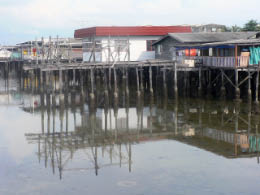
Floating Village |
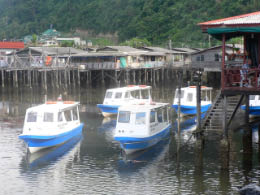
Floating Village |
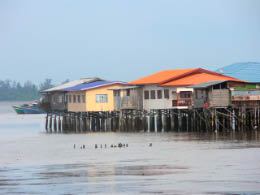
Floating Village |
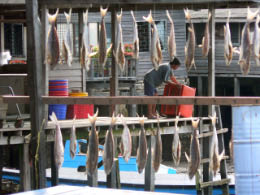
Floating Village |
We were served tea and fried bananas (no bananas for me!). I didn’t really enjoy our tea time – I was too busy running around, exploring the place and snapping photos.
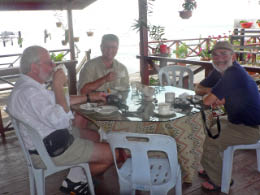
Terry, Jaime and Bill enjoying tea |
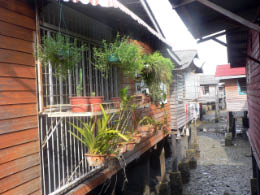
Hanging plants
|
On our way out, I passed out some jumping beans, much to the delight of the school kids and older guys.
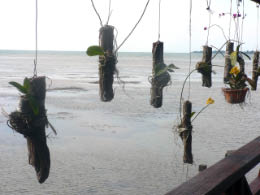
Hanging plants |
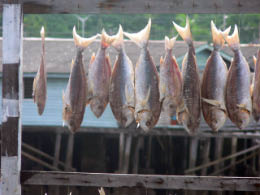
Hanging dinner
|
Terry was smart – he bought some Tiger beer at the village for 5 ringgets each (about $1.25). He shared them with us back at the hotel.
We took a shower and boarded the bus to go out for a group dinner at Ocean King Seafood Restaurant. Storm clouds were brewing. By the time we got to the restaurant, a thunderstorm was pouring buckets of water on the restaurant. The rickety old wooden place was built on stilts over the ocean. I screamed at the first clap of thunder (and then grew to expect it). The lightening was phenomenal and the rain was pouring so hard on the tin roof we couldn’t even hear each other. Seated at our table were Joe and Elaine (from Charleston), Bev, Terry, Jaime, and Tobi (who detests fish). The food was wonderful – soup, calamari, steamed fish, shrimp, veggies, and so on. We all ate so much and loved the electricity of the storm that surrounded us.
The storm was letting up just about the time we finished dinner. I loved Mother Nature's “dinner show.” They don’t make thunderstorms like that in San Diego.
We went back to our room to organize our things and get ready for our morning flight back to Kota Kinabalu. |











